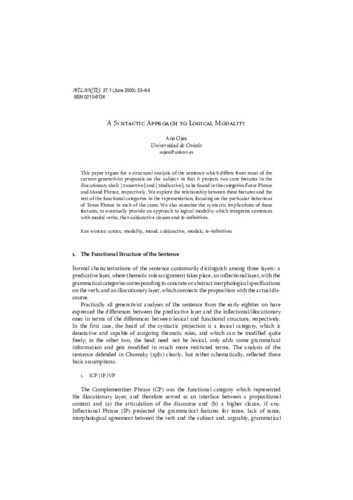A syntactic approach to logical modality
Autor(es) y otros:
Fecha de publicación:
Editorial:
The Spanish Association of Anglo-American Studies (AEDEAN)
Citación:
Descripción física:
Resumen:
This paper argues for a structural analysis of the sentence which differs from most of the current generativist proposals on the subject in that it projects two core features in the illocutionary shell: [±assertive] and [±indicative], to be found in the categories Force Phrase and Mood Phrase, respectively. We explore the relationship between these features and the rest of the functional categories in the representation, focusing on the particular behaviour of Tense Phrase in each of the cases. We also examine the syntactic implications of these features, to eventually provide an approach to logical modality which integrates sentences with modal verbs, that-subjunctive clauses and to-infinitives
This paper argues for a structural analysis of the sentence which differs from most of the current generativist proposals on the subject in that it projects two core features in the illocutionary shell: [±assertive] and [±indicative], to be found in the categories Force Phrase and Mood Phrase, respectively. We explore the relationship between these features and the rest of the functional categories in the representation, focusing on the particular behaviour of Tense Phrase in each of the cases. We also examine the syntactic implications of these features, to eventually provide an approach to logical modality which integrates sentences with modal verbs, that-subjunctive clauses and to-infinitives
Colecciones
- Artículos [37532]
- Filología Inglesa, Francesa y Alemana [582]
Ficheros en el ítem




